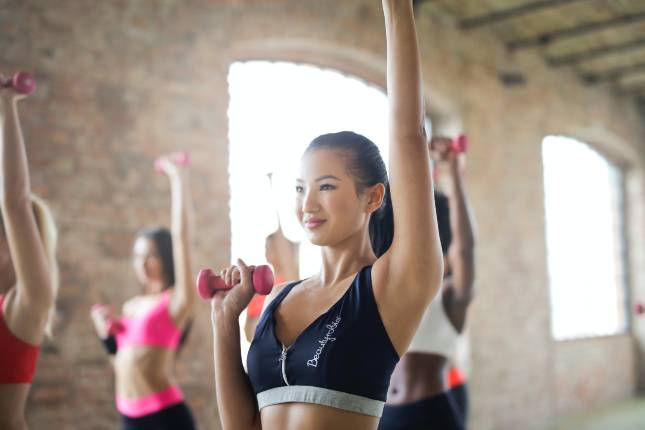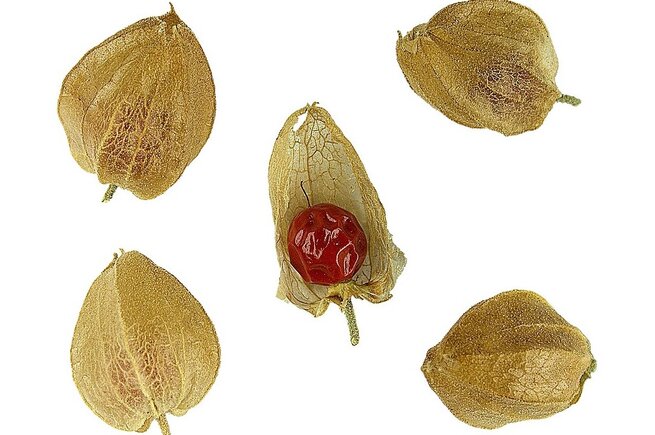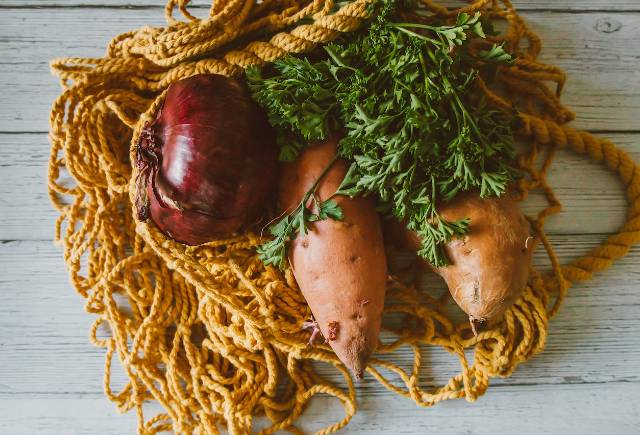Let’s explore the critical role of the mineral iron in women’s health….how indispensable it is for us, and how it helps us maintain strength and vitality across all our life stages. I’ve looked at the research, the insights and compiled a comprehensive guide here to help you navigate the path of iron deficiency, that’s becoming increasingly common in Australian women. In this article you’ll learn what foods to eat, what supplements can help and how to dose them as well as how to recognise the signs and symptoms of iron deficiency and its more serious sister, iron deficiency anaemia.
I’m a classically trained naturopath, but I’m also trained in Chinese Herbal Medicine, so I’ll be sharing some Eastern-inspired wisdom with you in this article. If you like this sort of approach, check out my podcast episode A Natural Approach to Iron ~ Nourishing the Sea of Blood.
In Chinese medicine iron is a building element of Blood, one of the Vital Substances, and many blood-related conditions involve an issue with iron (or lack of iron). So I’m looking at iron deficiency through an holistic lens, giving you more than supplements to think about. You also need to know what to eat and how to tailor your lifestyle to give you the best chance of raising your iron levels naturally. Thinking of just taking a supplement and hoping that does that trick? Well it might, but it’s probably not enough to make a difference long term. And you don’t want to be on that iron supplement forever.
Iron is ⫷ Life ⫸ Force
What’s tiny, almost black and symbolizes the purest essence of our feminine Yin energy? ➳ Iron particles.
Being a woman is a journey. From the moment that menarche (our first menstrual bleed) begins, we enter the realm of cyclical transformation, with each cycle bringing with it an internal process of building, tension, shedding and ease. Among all this, the menstrual bleed. You may be on a form of contraception that prevents this process, but for many of you reading this article its quite likely you’re having regular (perhaps heavy) bleeds, because that’s the main way we lose our vital iron, and the reason why cycling women are more prone to iron deficiency than men. Iron is just part of our physiological terrain and without it our blood would be vacant, grey and lifeless. It’s iron that imbues our blood, muscles and tissues with a rich red hue. Iron gives us energy and powers our life force. It’s a dynamic element, and it needs constant replenishing.
The prevalence of iron deficiency in Australian women
Reflecting on my cases in clinic over the past couple years, I found that nearly half of my clients either exhibited signs of iron deficiency or had blood tests to prove their iron levels were low. This aligns with global estimates that over 30% of the worlds population is iron deficient, particularly women and children, my main clientele. According to Scientific American around 2.4 billion people experience iron deficiency worldwide, with 1.2 billion suffering from iron-deficiency anaemia, which is a more severe form of iron deficiency, a later stage in the iron deficiency process, one could say. Considering our global population sits around 8 billion, that’s over 25% of people globally that are affected by iron deficiency. And consider also that a lot of us don’t always know that we’re iron deficient. There’s likely to be even higher levels than what are recorded or documented.1
Total Global Population: ~ 8 billion. Prevalence of Iron Deficiency Worldwide: ~2.4 billion. % of people globally who are iron deficient = >30%
Scientific American 2021
How to tell if you are iron deficient
Now with all this talk about the role of iron in blood and life force, it will come as no surprise that low iron levels translates to symptoms in the cardiovascular system, which is essential an infrastructural network of vessel channels and a pump that can’t function without blood. The main symptoms of iron deficiency typically reveal cardiovascular stress or impact.2
These are the symptoms to look out for if you think you might be (or be becoming) iron deficient. Make a note of any that you experience, and keep an eye on those symptoms over the coming weeks. Especially, notice if they worsen after a menstrual bleed.
- Fatigue
- Lethargy
- Poor concentration
- Anxiety
- Panic
- Dizziness
- Weakness
- Headaches
- Shortness of breath
- Cold hands and feet
- Pale skin
- Restless Leg Syndrome
- Hair Loss
- Heart palpitations
- Dry mouth
- Increased risk of infections
Make a mental note now, “how many of these symptoms have I experienced in the last month? 10%, 20%, 50%, all of them? Some of them are more common than others and could have other causes, headaches for instance could be food related or vision related, or stress related. Fatigue could be diet related, or you might be pregnant. So look at the combined symptom picture rather than focussing on just a few, and rule out other causes that might be behind any of these typical iron deficiency symptoms. I work with iron deficiency frequently. If you’re just over it (!) and want to get working on your iron levels with an evidence-based protocol, go ahead and book yourself in for a one-on-one consult with me:
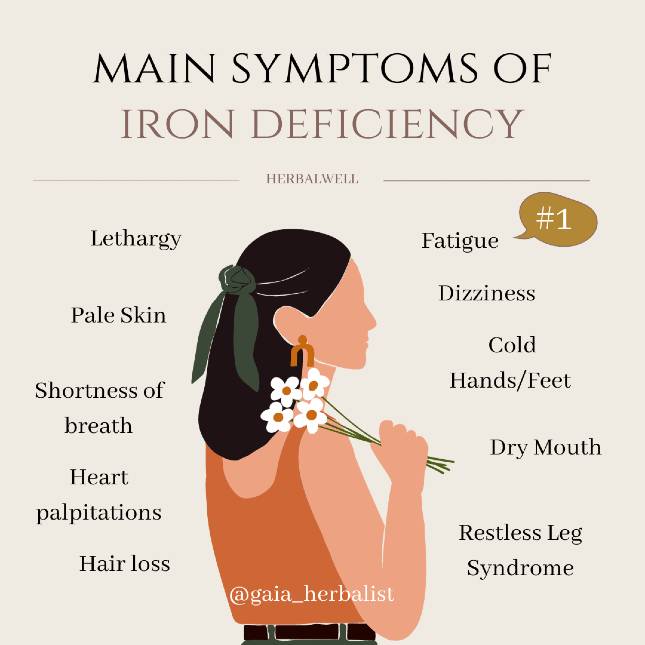
(Sze, 2023)
The number one symptom is fatigue, which is why iron deficiency can go un-noticed for many of us because it’s such a general symptom. We think our fatigue is probably just from working too hard and fast, or lack of sleep. Certainly those things play a role. The best approach is to monitor symptoms. If they don’t improve with rest and good nutrition, then you know there’s a chronic physiological imbalance underlying it….you could also just go and get your GP to test your blood iron levels to know if it IS iron deficiency. Want me to organise this for you? Email me and I’ll set you up with an iron test prescription that you can take to your nearest pathology lab in Australia. Simple!
Iron-Deficiency Anaemia
In women, the progression of iron deficiency can escalate to a condition known as iron-deficiency anemia, which involves a complex interplay impacting multiple systems and tissues within the body. At this stage, fertility and hormonal health can face significant compromise, resulting in disrupted menstrual cycles, lighter or absent periods. In cases of pregnancy, iron deficiency raises the risk of preterm birth or low birth weight. Moreover, there’s an increased likelihood of complications such as pre-eclampsia or maternal bleeding during pregnancy. Shockingly, it’s estimated that approximately one-fifth of maternal deaths are attributed to iron deficiency.7
Physiologically womens bodies are blood and earth bodies. And blood is the energetic foundation of a womans health, in a 2014 literature on ancient holistic perspectives on womens health, researchers concluded that a womans health, sickness, treatment outcomes are all deeply influenced by how well nourished and regulated their blood is, and that treatments like herbal medicine and acupuncture are so effective for fertility because they regulate the flow of blood through the uterus and ovaries.
Cochrane et al (2014)
Normal vs Optimal Iron
Often we ask “how much iron do we need as women?” when a better question to ask is “what are the optimal iron levels for women?”. Naturopaths are always more interested in achieving ‘optimal’ because we’re wanting to see a significant difference in things like energy, stress resilience, immune function and fertility.
So remember that while the blood tests you receive are giving you a national average standard for iron levels, you will most likely want to get your levels up higher. Typically Australian labs give you a number of iron study elements including total iron, transferrin, saturation, total iron binding capacity (TIBC) and the more accepted marker for iron stores, ferritin. The purpose of an iron panel is to reveal how healthy your iron levels are by measuring these different aspects of iron. It means you get an idea of:
- how much iron is circulating in your body (total iron)
- how much the body feels it needs to circulate more iron (transferrin)
- how much your iron transport molecules are saturated with iron (saturation)
- how much iron you’re keeping a hold of in your liver, to sustain you (ferritin)
All of these are listed in your results with their values as well as the lab’s reference ranges so that you have an idea of how your levels compare with the majority of the population. I like to also consider reference ranges can be a little too generalized. If I have petite clients or larger body build clients I’ll consider that when looking at the reference ranges. I’ll also consider that if a large proportion of Australians are iron deficient, then the reference ranges (an average of the population) may be a but skewed. That’s where seeing an experienced clinician can help you decode your results more thoroughly.
Reference ranges on iron panels differ between labs, so there’s a bit of variation out there. You’ll have to look at the results in front of you to really see where you’re placed according to your testing lab. So use this information as a general guide but its not necessarily going to match the test you’ve done.
NSW Health suggests the normal iron levels will sit between 8 – 32 micromole (umol/L) per L. This is close to Australian Clinical Labs which gives a lower limit of 10 and higher limit of 30. So sit between these and you have normal iron levels.4
If its lower than 10, then you definitely want to eat and supplement to get more iron into your bloodstream. The Iron Deficiency Experts Group of Australia recommend going by the ranges on your lab results, and if the ‘serum iron’ sometimes just called ‘iron’ is low or trending towards low, then you haven’t got enough iron but you’re not at an anaemic stage yet. This is where you want to focus on supplementing to lift your levels, prevent anaemia and have a blood nourishing diet. If the iron level is sitting well in the normal range or even too high, check for iron overload. 5
Ferritin is the most important marker. It tells you how much iron you have in storage, because while 60-70% of your iron is hitchhiking around your body in red blood cells, around 30% of it is sitting in storage in liver cells. The remaining 10% or so get used in enzymes or cytochromes.
If your ferritin is low, you can assume iron is deficient in all your tissues. Normal Ferritin is over 30micrograms (ug/L) per L, naturopaths like it higher -say around 80. if you’re sitting around 30 you most likely are exhibiting iron-deficiency signs. One of the more frequent experiences I’ll have in clinic is women who test normal on their iron study go to their medical practitioner for help with fatigue, and walk away being told their iron is fine, but really it isn’t, its not optimal iron, that’s what you want to strive for. Its no fun for the woman either because it negates her symptoms and she most likely IS feeling lethargic and foggy. All the time.
The optimal iron levels for women is 60-140 micrograms per L, and one of the other labs I used to use for testing, they’re reference range for normal ferritin levels for a woman between 15-50 yrs old is up to 200 micrograms per L. if you’re wondering about younger girls, for girls up to 15 years old, and it’s the same for boys of that age group too, the reference range is between 20 and 140 micrograms per L.4
As a summary, here’s what you can expect to see in general iron deficiency: Low total iron, a high or normal transferrin level, same with the total iron binding capacity TIBC, but the saturation will be low and the ferritin will also likely be low. Don’t use social media though for a diagnosis, see your therapist or come and see me in clinic for a more comprehensive interpretation if you think you may have iron deficiency. We can also look at other factors that could be causing your symptoms too. It may not be iron.
Australian Lab Reference Ranges are usually 10 – 30 umol/L for normal iron. The Optimal level is around 60-140mcg/L. Here's what to do in various situations: Chronically low iron levels: come and see me or see your doctor. Temporarily low iron levels: read on to find out about supplementation and diet. High iron levels: ask your doctor to check for iron overload or haemochromatosis.
Now that we now what we’re aiming for, let’s look at how we can introduce more iron into our diet through food. I want to share an eastern approach and also tell you what the research says about specific diets in iron deficiency, like the Mediterranean and Paleo diets. So read on for more iron-rich content 🙂
‘Blood Foods’
In Oriental medicine there’s a theory around ‘blood foods’ and ‘blood herbs’. It adds another layer to your iron-boosting toolkit. These foods and herbs resemble the dark, rich, red, velvety blood that you’re trying to build-up. Liver from animals is considered an especially good source of iron across all healing systems and in Chinese Medicine the liver is important as a ‘Blood reservoir’. For instance, with womens cycles, the Liver is seen as the system that holds the ‘Sea of Blood’ which is later released via the period.
If you’re a woman having cycles, give yourself extra nourishment if your bleeds are too light or sluggish, your blood may need building up. And add some gentle spices like cinnamon and ginger to get your blood moving more freely through the uterus and ovaries. The normal amount of blood loss in any given cycle is 80mL. If you think you’re losing more than this, then you’ll also be losing more iron than normal.6
To boost blood foods in your diet, increase your intake of:
- Legumes: Aduki bean, Black Soybean, Kidney bean
- Date, Chinese Red Date
- Spinach, Kale, Kelp and Leafy Greens, Watercress, Seaweed, Silverbeet, Red Chilli, Green Chilli, Sundried Tomato
- Meat: Bone Marrow, Liver, Beef, Chicken Liver (very high in iron), Red meat
- Chicken egg
- Red Miso
- Red wine, Cocoa power
- Fruits: Cherry, Longan berry, Figs, Dark Grapes
- Culinary herbs for cooking: Parsley, Coriander leaf, Basil leaf
And there are also ‘blood herbs’, the herbal teas, decoctions and tinctures that can assist in low iron levels. Herbal teas can be consumed or added to smoothies or even incorporated into meals. I’d recommend Nettle leaf, Dandelion leaf tea, Yellow Dock, Alfalfa, Moringa and Ashwagandha which makes for an amazing latte with some milk and honey. Check out my Ashwagandha latte recipe here.
Keep in mind that it’s important to consult a healthcare professional before adding herbal supplements into your routine, especially if you have underlying health conditions or are taking other medications. A naturopath or herbalist like myself can guide you to what is safe and efficacious.
The recommended daily iron intake via the diet for women 19-50 yrs is 18mg/daily. For younger women, 14-18 yrs it's 15mg/daily. For women over 50 yrs it's 8mg/daily because usually we're not losing iron via menstruation anymore. For pregnant women the iron intake is 27mg.daily and for lactating women it's 9mg daily.
Nutrition Australia
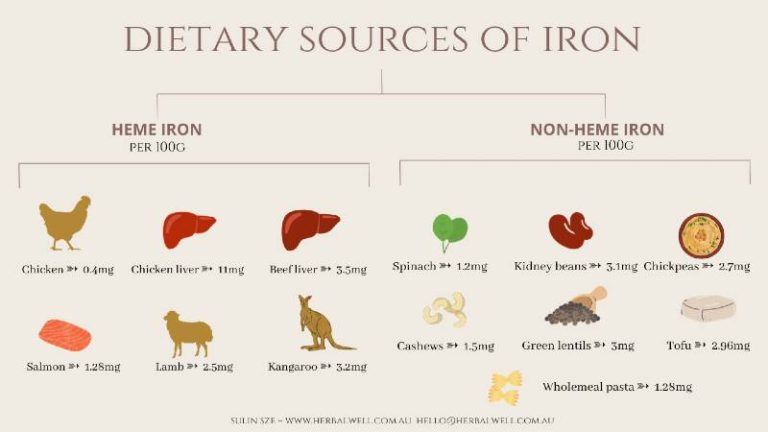
Top Iron-rich foods including the meat (heme) type and the plant-based (non-heme) type. (Sze, 2023)
How to get more iron from the diet
The main cause of iron deficiency in Australia is inadequate iron in the diet. Here’s what is probably happening for you right now if you eating a typical western diet. You’re taking in around 15-20mg of iron in your daily diet, around 10% of this is meat derived and the remaining 90% is from plant-based sources. The food will be moving through your stomach, hopefully acted upon by a healthy amount of stomach acids which release iron out of meats (if you take antacids or antihistamines regularly your stomach acids may be compromised), and then it will make its way to your duodenum where only 10% of the consumed iron will be absorbed by cells in the intestinal lining. So you took in the recommended daily intake of iron, and you only absorbed 1.5 – 2mg. Essentially, if you’re already iron deficient, diet isn’t going to be enough to get your levels back up and you’ll need supplementation.8
And furthermore, if you have a problem with your gut lining, or a condition like SIBO (Small intestinal bacterial overgrowth) or SIFO where fungal overgrowth is the problem,…then you’re ability to absorb iron is already compromised. This is because its your intestinal lining cells, called enterocytes, that absorb iron for you. You need them to be healthy and any chronic gut condition will compromise them.
- You can use nutritional enhancers to increase your iron absorption from food such as vitamin C, folic acid, citric acid, and foods rich in the amino acid cysteine. Meat, fish, poultry enhance iron absorption. Vitamin can help to offset the inhibitory effects of coffee and tea. Did you know drinking coffee and black tea with your food will reduce your iron absorption?4
- Avoid taking your iron supplement too frequently, or more than once daily, both which these inhibit iron absorption. I’ll tell you more about hepcidin and liver management of iron absorption in another article.
If you’re a menstruating women you’ll be losing around iron daily. And if you have any blood in the stool, or blood when wiping, you may be losing iron rich blood internally. From the stomach area if the blood is darker, or the lower digestive system if the blood is lighter. You also may have coeliac disease which in itself will limit your nutrient absorption capacity. Anything that’s damage the linings of the gut will do that.
If you follow a Mediterranean diet, this may not be the best choice for iron deficiency or anaemia. The mediterranean diet limits red meat and includes several foods rich in phytates, chemicals that are known to reduce absorption of iron, like almonds, plant seeds, beans. Lentils, rice and grains. You can still follow this diet generally but I’d recommend upping your intake of fish along with using iron supplementation.
According to Harvard University, and this makes perfect sense, the Paleo diet is a suitable diet for people with a tendency to low iron. That’s assuming you’re happy to eat meat.9 They rank seaweed as particularly high in iron, then oysters, soybeans, pumpkin seeds, lentils, spinach and kidney beans followed by beef and turkey.
So you can see in there lots of plant-based options for iron too, if you’re vegetarian or similar. There are basically two types of iron you can eat. You can get your iron from plant sources, this is your non heme iron. Or you can get it from animal sources and this is heme iron. Heme iron is the most bio-available, so you can absorb it more easily. On the other hand the absorption rates of plant based iron are low
Here's will give you 18mg of iron: if you eat cereal for breakfast buy an iron fortified one, have cannelloni beans for lunch, make a chickpea or tofu curry for dinner and add some organic beef liver powder to it. On another day eat sardines on toast for breakfast and top with fresh spinach leaves, then have lentil soup for lunch and braised beef stew with added beef liver powder and nutritional yeast for dinner. Then finish the day off with some dark chocolate. If you combine this sort of approach with the Chinese medicine blood nourishing diet, I think you’ll come off a winner. You still need to supplement if you’re already deficient, but that’s not a forever thing. Once your stores are back up you can move to dietary provision of iron and go from there.
Here are some great iron-rich meals you could try:
- Tabouli Salad
- Iron-Boosting Orange-Green Smoothie
- Iron-rich smoothie
- Spinach & Strawberry Salad
- Braised Beef with Carrots and Potatoes
- Tofu Piccata
- Roast Broccoli with Lentils and Lemon
- Angelica, Ginger and Lamb Soup (needs the Chinese herb Dang Gui/Angelica)
- Warm Hummus with Pine Nuts, Raisins and Olives
- Tofu & Spinach Cannelloni
- Spiced Curry Lentils
- Kidney-bean Chocolate Cake
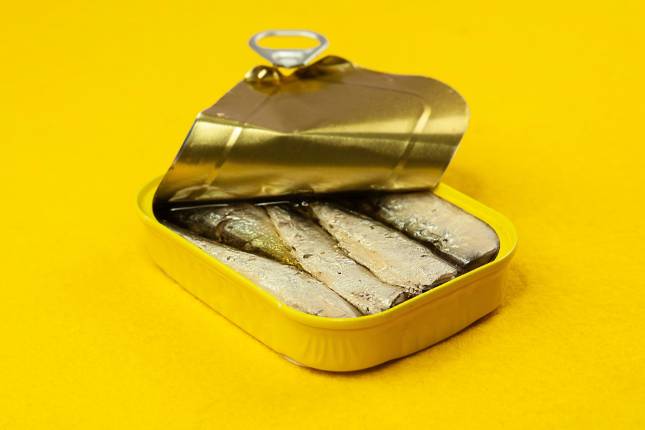
(Karen Laårk Boshoff, 2023)
How to choose an iron supplement
My number one rule with iron is, match it to the person and monitor usage. Don’t take it just because, and don’t grab the cheapest one on the shelf. A naturopath can help you find out which iron form and dosing regimen is going to actually work for you to safely and effectively manage your iron levels. Come and see someone like me or see a nutritionist to work out whats best for you. That said, I’ll give you some pointers below but this isn’t therapeutic advice, it’s educational. Always check with a health professional before taking anything medicinal.
Choosing which iron supplement is best for you depends on your age, sex, deficiency level and on other factors like gut health. Most iron supplements come in a salt form like ferrous fumarate which might be cheap, but isn’t absorbed as well and can cause nausea, diarrhoea or black stools. If you’ve had a reaction to an iron supplement, it may well have been in this form. Check the label and if you see this listed there, move on!
Iron chelate forms like iron bisglycinate are a better choice. They’re more absorbable and less likely to irritate and cause gut symptoms. They’re usually in smaller doses so less likely to set off the hepcidin brigade. I tend to use the iron bisglycinate form, with dosages around 120mg iron bisglcyinate, it ends up being equivalent to 24-27mg elemental iron, or thereabouts.
Getting the most out of your iron supplement
Follow these tips to get more benefit from your iron supplementation. The sooner your levels are optimal, the sooner you can get back to enjoying life and pure vitality.
- Be consistent and take your supplements for 3-6 mnths or until your iron levels pick up. It takes around 2 months to restore normal haemoglobin levels and more than that if you have heavy periods.
- You’ll get the most absorption if you take it on an empty stomach providing it doesn’t upset your stomach. I give my clients an extra gentle iron supplement and we rarely have issues like this. So you have options if your current supplement isn’t going down well.
- Take a high quality vitamin C powder or supplement. This can help with iron absorption.
- Avoid taking any of these at the same time as your iron supplement: milk, antacids, raw vegetables, chocolate, coffee. They interfere with iron absorption.
If you think you may be iron deficient, possibly anaemic. Or perhaps it’s a friend or family member, and you’re looking for a solution to ongoing fatigue, mental fogginess, headache, breathlessness and other typical symptoms of iron deficiency, just know that there is a solution for you out there. Whether its supplementation, intravenous iron, herbal teas or looking at a diet revision, there are ways you can work holistically on your iron status. Lifestyle also plays a role so look also at your stress levels, and whether you have enough stress coping tools to support you like breathwork, walks, meditation and yoga. From what I’ve observed as a womens natural health clinician, iron deficiency requires a holistic approach that covers everything from diet, lifestyle and herbs, and it can really help to have a practitioner like me to guide you in this. And by popping some of those iron enriching foods I mentioned onto your shopping list, you’re already taking the first steps to transforming your diet into a blood nourishing one.

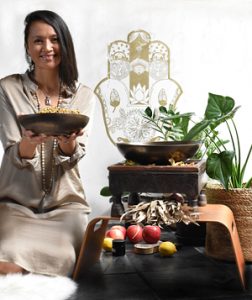
Hey there! Welcome to my world of totally natural and powerful healing medicines. Medicines from nature. Medicine from Source. I’m a naturopath and herbalist with extensive clinical experience working with a range of health conditions including hormonal, metabolic, mental health, sleep and more.
I’ve brought together years of clinical and teaching experience, academic skill and curiosity to bring you this blog. I hope you enjoy it! If you do, leave a comment, I’d love to hear from you!

References
- Russell, S. 2021. The Global Iron-Deficiency Crisis. Scientific American.
- Nutrition Australia. 2021. Iron Factsheet
- Cochrane, S., Smith, C. A., Possamai-Inesedy, A., & Bensoussan, A. (2014). Acupuncture and women’s health: an overview of the role of acupuncture and its clinical management in women’s reproductive health. International journal of women’s health, 313-325.
- Barnes, C. Prof. The Issue of Iron Deficiency in Women. Australian Clinical Labs.
- Pasricha, S. R. S., Flecknoe‐Brown, S. C., Allen, K. J., Gibson, P. R., McMahon, L. P., Olynyk, J. K., … & Robinson, K. L. (2010). Diagnosis and management of iron deficiency anaemia: a clinical update. Medical Journal of Australia, 193(9), 525-532.
- Briden, L. 2021. Hormone Repair Manual. Pan McMillan Australia.
- Camaschella, C. 2019. Iron deficiency. Blood, The Journal of the American Society of Hematology, 133(1), 30-39
- Yiannikourides, A., & Latunde-Dada, G. O. (2019). A short review of iron metabolism and pathophysiology of iron disorders. Medicines, 6(3), 85
- NA. 2015 A healthy diet is the key to getting the iron you need. Harvard health Blog.

